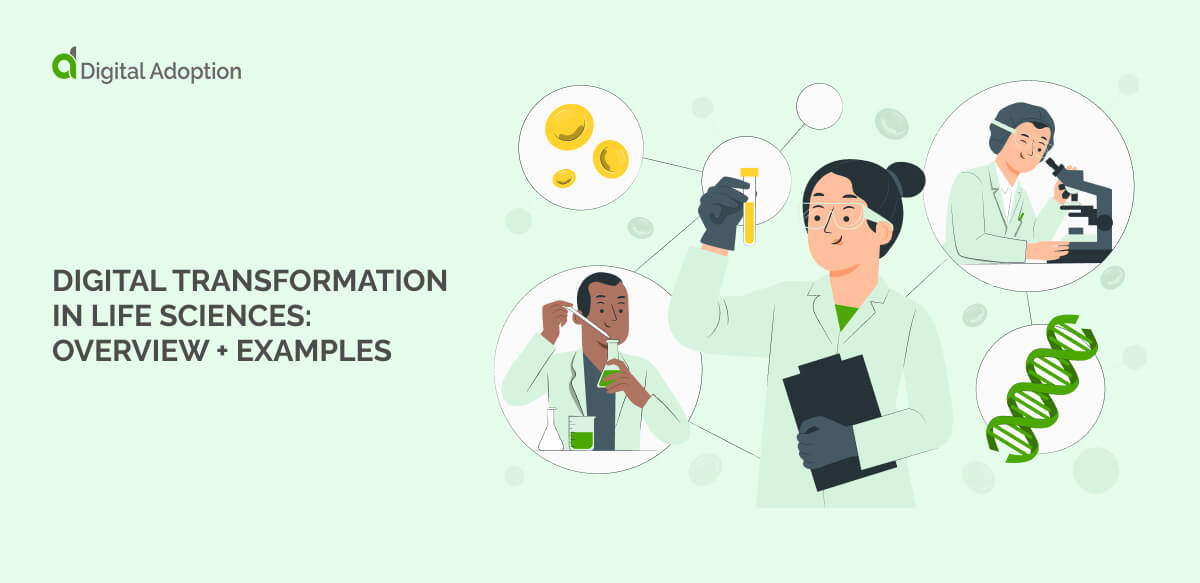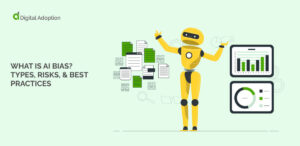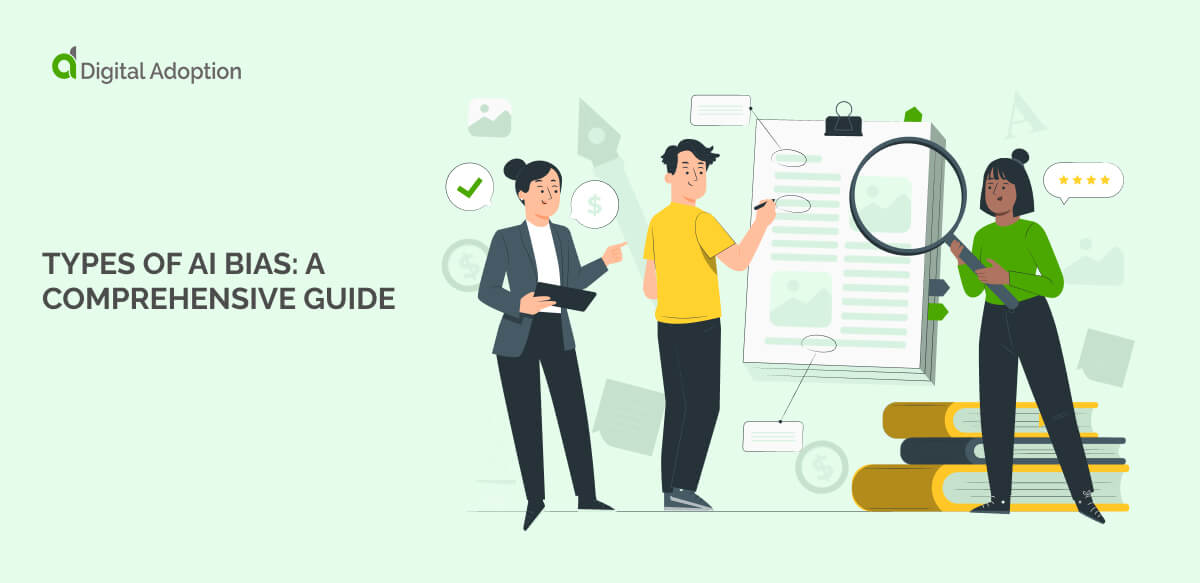Life sciences are falling behind in digital transformation compared to other industries like telecom and retail. This point is also valid for digital transformation in pharma.
The reasons are partly due to a lack of understanding of organizations that produce life sciences equipment with practitioners’ decision-making processes and the ethical complexity of introducing new technologies like privacy and legal compliance.
Lack of venture capital investments in previous years could also reduce life sciences transformation spending. Venture capital spending in life sciences, with deal values dipping by 22% from USD 54.8 billion to 42.1 billion.
We will begin with a definition to help you understand the role of digital transformation in life sciences. We will then move on to three digital transformations in marketing examples, including what you can learn from each and the benefits and challenges to help you successfully kick off your digital transformation.
What is digital transformation in life sciences?
Digital transformation in life sciences involves pharmaceutical organizations adopting new digital technologies to enhance their basic science, applied science, and research processes. Competition and changing customer needs are key drivers of these changes.
Critical areas include analytics, digital maturity, improving operations, customer experiences, and leveraging big data. Examples of technologies include AI for researching new drugs, wearable technologies, and automating laboratory tasks. These technologies help organizations generate higher revenue while maintaining patient well-being.
Investment is essential for innovation; if the funding doesn’t exist, leaders cut innovation from budgets, and transformations don’t happen. Covid-19 influenced this spending dramatically, though now it appears to be regaining traction.
However, digital transformation is the key to growth, and innovation in life sciences drives this innovation.
What are some examples of digital transformation in life sciences?
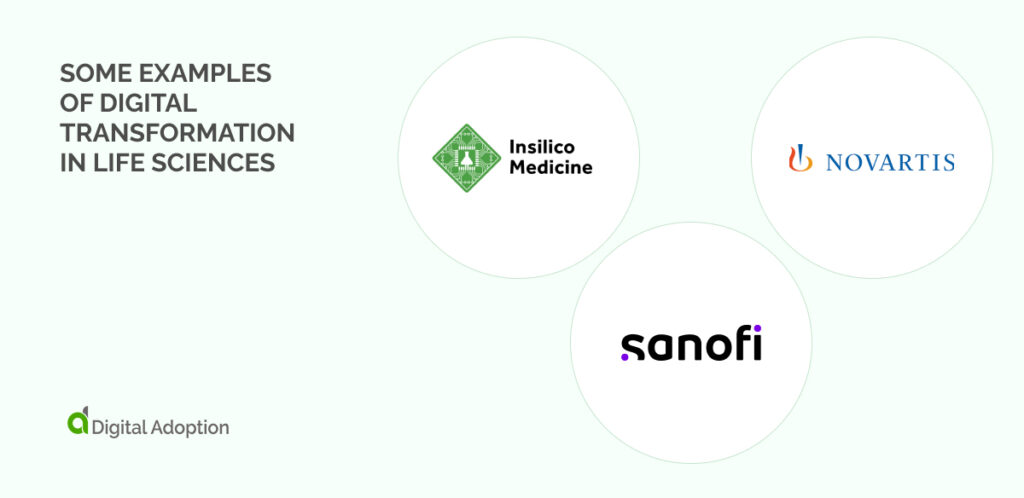
There are many examples of digitization in life sciences. Still, the three below cover some of the main technologies and approaches today: AI to discover new drugs, digital wearables, and centers of excellence.
These all succeeded in transforming their organizations, offering users safe, convenient, and efficient services and products and increasing revenue for the organization that provides these innovations. Let’s begin with Insilico’s use of AI to research a new drug and get it to market in record time.
Insilico: AI for drug research
In June 2023, Insilico Medicine’s drug candidate for pulmonary fibrosis became the first entirely AI-discovered and AI-designed drug to enter a phase 2 trial. This achievement was a significant industry milestone and ushered in a new age of the AI-augmented workforce in life sciences.
This AI-driven digital transformation happened in less than 30 months, roughly half the time required by traditional methods. This acceleration was made possible by AI’s efficiency and speed, which achieved these results at a fraction of the typical cost.
This venture exemplifies how advanced AI technology and deep expertise in therapeutic areas can yield remarkable outcomes.
As we further explore the potential of AI and machine learning, such collaborations between digital innovators and R&D giants are set to become the norm.
These partnerships will increasingly drive progress in drug discovery, showcasing the transformative impact of integrating AI into the life sciences.
What can you learn from this example?
We can learn several lessons from Insilico’s transformation, including:
- AI can expedite new drug discovery: Embracing AI can significantly accelerate drug discovery, reducing timeframes from years to months.
- Using AI reduces costs: Leveraging AI reduces costs, making drug development more efficient and financially sustainable.
- Expert collaboration is critical to innovative breakthroughs: Collaborating with AI experts enables breakthroughs, combining technological innovation with scientific expertise for superior outcomes.
Novartis: Digital wearables
Novartis is a pharmaceutical company that prides itself on innovation. One of the most recent examples of their innovations is becoming a data powerhouse through wearable technologies. They began using these wearables as part of their data transformation.
Wearable sensors continuously track sleep, activity, and fatigue in clinical trials. This real-time data, called “digital endpoints,” makes trials more relevant, objective, and focused on patient well-being.
In 2021 alone, Novartis used wearables and digital endpoints in 16 trials, including their CAR-T cell therapy program. Wearables helped detect serious side effects early in outpatients, improving patient safety.
Novartis’ data prowess extends beyond wearables. They’ve broken down data silos by creating a company-wide platform that integrates over 100 data sources.
These siloes allow real-time data sharing, analysis, and informed decision-making. This is a groundbreaking win for data innovation.
What can you learn from this example?
We can learn several lessons from Novartis’s transformation, including:
- Tracking health data remotely saves time and money: Novartis used wearables to collect real-time patient data for better trial insights, saving the organization and patients time and money.
- It is essential to improve patient safety continuously: Novartis could easily monitor for early side effects with wearables, especially in outpatients, to provide safety that aligns with convenience.
- Breaking down data silos offers a unified view of data: Novartis integrated all data sources for a unified view and better decision-making.
Consider how these examples may apply to your life sciences organization. If the specific technologies may not be suitable for you, the learning you take from the approaches these organizations may be invaluable in helping your next digital transformation succeed.
Sanofi: mRNA centre of excellence
This endeavor aligns with their strategic acquisition of Translate Bio in 2021, bolstering their commitment to advancing vaccine development.
Translate Bio, renowned for its pioneering mRNA therapeutics, harnesses cutting-edge mRNA technology to develop clinical-stage treatments for various ailments, including lung, pulmonary, and infectious diseases.
Sanofi is revolutionizing its research and development paradigm through four distinct technology platforms that enhance drug discovery and production.
For instance, within their Biologics and Large Molecules platform, Sanofi is spearheading the implementation of advanced analytical methodologies to oversee all facets of biologics manufacturing and ensure consistent product quality and safety.
Their Device Development Unit collaborates closely with patients to engineer innovative delivery mechanisms for biologics necessitating injection due to their molecular dimensions.
This multifaceted approach underscores Sanofi’s unwavering commitment to driving innovation across the pharmaceutical landscape.
What can you learn from this example?
We can learn several lessons from Sanofi’s’ transformation, including:
- Embracing new technologies provides a competitive edge. For example, Embrace cutting-edge technology like mRNA to revolutionize vaccine development and manufacturing processes.
- Strategic acquisitions can drive digital transformation: Invest in strategic investments to strengthen capabilities and accelerate digital transformation initiatives.
- Patient collaboration can lead to new standards: Collaborate with patients and employ advanced analytics to enhance product quality and safety standards.
What are the benefits of digital transformation in life sciences?
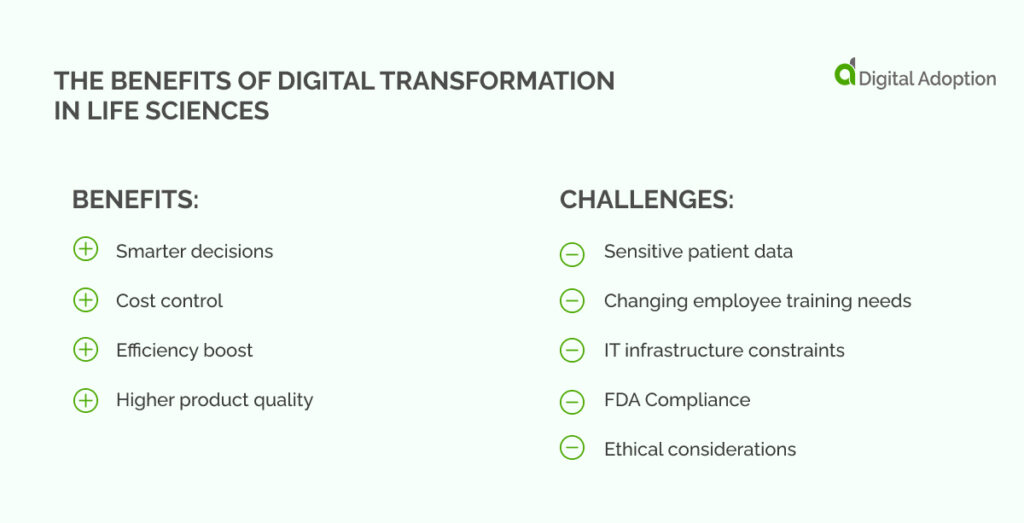
It’s a missed opportunity that life sciences organizations haven’t begun to digitally transform like other sectors because of the huge benefits these transformations can provide. One of the first benefits is more intelligent decision-making driven by higher-quality data.
Smarter decisions
Intuition-driven decisions are becoming obsolete. Digital tools now offer real-time supply chain visibility, enabling companies to identify inefficiencies and optimize processes effectively.
With access to accurate, up-to-date data, businesses can make informed decisions that enhance overall performance.
This data-driven approach ensures better strategic planning and operational outcomes, minimizing the risk associated with guesswork.
By leveraging advanced analytics and real-time monitoring, companies can anticipate challenges and opportunities, resulting in more agile and responsive supply chain management.
This shift towards data-centric decision-making not only improves efficiency but also boosts competitiveness in the market.
Cost control
Digital transformation extends beyond advanced technology; it focuses on integrating machine learning and AI with seamless machine communication to enhance manufacturing operations.
This integration saves substantial costs by enabling automated error correction and predictive maintenance.
These technologies lower per capita costs by reducing downtime and preventing costly repairs. Additionally, digital tools streamline resource allocation and minimize waste, contributing to cost efficiency.
Automating routine tasks allows employees to focus on higher-value activities, optimizing labor costs. Overall, this approach ensures more efficient production processes and better financial management.
Efficiency boost
Digital tools allow full data collection at all manufacturing facilities, giving a complete view of operations. This extensive data capture lets companies find and fix inefficiencies, leading to focused improvements that boost production efficiency and productivity.
Insights in real-time empower decision-makers. They help them pinpoint bottlenecks and speed up production. Better visibility into operations helps find problems early. It also helps with ongoing improvement.
Digital tools improve production by improving resource use and cutting downtime. This approach ensures that companies maintain high output and improve efficiency.
Higher product quality
Transformation enhances efficiency and product quality. Access to real-time data and automated reporting makes quality assurance easy. They also greatly cut the chance of errors.
Relying on digital documentation eliminates the need for paper records. Paper records are prone to mistakes. This shift to digital processes ensures better tracking. It also ensures compliance with strict quality standards.
Better traceability and accountability improve pharmaceutical quality. They also help the drugs meet regulations more consistently.
By using digital tools for quality management, companies can achieve better product consistency and customer satisfaction. This step will ultimately improve their reputation in the market.
Drug companies can boost profits by going digital and ensuring their drugs are safe and effective. This benefit is a win-win for both the industry and patients.
What are the challenges of digital transformation in life sciences?
Many challenges have slowed life sciences. They have caused it to lag behind other sectors. This point is true for transformative and disruptive technologies.
You will face challenges. They include patient privacy, ethics, and IT. Overcoming them will let you set up a successful transformation and beat competitors.
Sensitive patient data
Pharma’s shift to digital hinges on vast patient data. This shift has raised privacy worries. Companies must follow GDPR and HIPAA regulations. They do this to avoid big fines and maintain patient trust after a data breach.
New technology must obey regulations. Leaders must approve it to avoid harm to the organization’s reputation.
Changing employee training needs
The digital revolution in pharma demands a skilled workforce. New tools like QMS and RIM systems require upskilling. These technologies are most useful through proper onboarding and training.
Untrained employees struggle with these new technologies. This struggle hinders productivity, ROI, and, in the end, the bottom line. It’s natural to resist change. So, good change management is key to getting the most from digital transformation.
Life sciences companies are rolling out new digital tools. They must invest in training for employees. Untrained staff struggle with these new systems. This problem hinders productivity and ROI. This domino effect impacts the bottom line. It ultimately affects output, the customer experience, and revenue.
In addition, the more transformations employees experience, the better their resilience and digital transformation skills will become, allowing them to become agile and less likely to resist change.
Introducing employees to new digital skills may lead to resistance and pushback. Companies must implement effective change management initiatives to ensure they get the most out of their digital transformation.
IT infrastructure constraints
Embracing new technology in pharma isn’t just about buying the latest gadgets. It’s about creating a seamless ecosystem. This system empowers your workforce.
Integrating and moving key data to the cloud (or a hybrid system) is key. This approach will break down data silos and create data warehouses all can use. This data platform unifies data. It gives a complete view. It helps with decision-making.
Technology changes are complex. Invest in building an internal IT team. They should be able to handle integration issues and support applications. Alternatively, consider partnering with a digital transformation consulting firm.
- Employee support: Equip your IT team with the tools to provide real-time.
- Help desk: Enable employees to submit specific issue tickets.
- Self-service portals: Create curated dashboards with answers to common IT questions.
- Digital Adoption Platform (DAP): Integrate in-app tutorials, nudges, and wikis directly into your applications, providing easy access to internal documents, training resources, and more.
FDA Compliance
Always remember patient safety and follow the law. Seek tech that makes it easier to follow the FDA and other changing drug rules. Always prioritize patient care during the digital transformation process.
Investing in employee training, robust IT, and compliance all help a digital transformation in life sciences.
Ethical considerations
It’s exciting to advance pharma technology as much as possible, but ethics play a crucial role in how organizations use technology.
Technology is integrating deeply into healthcare. Keeping health data private and secure is paramount. As these technologies see wider use, ethical frameworks guide the responsible use of AI and big data.
These guidelines are complex. They prevent biases and ensure fairness in treatment outcomes. They also help navigate informed consent and patient autonomy in digital interventions.
Upholding these ethics promotes trust, supports rules, and ensures tech progress benefits all. It also avoids harm or exploitation of the vulnerable.
Catch up by launching a digital transformation
The life sciences sector has been slow to adopt new technologies. It has lagged behind other sectors for a long time. But it is starting to catch up. So, now is the time to join the innovation explosion. This action will ensure you don’t miss out on the growth.
You will benefit from starting a digital transformation. You can use some of the tools above. They include single-use manufacturing. They also include wearable tech. They also include centers of excellence. These benefits include better products. They also bring faster time to market for new drugs. They also make clinical trials more efficient.
Catch up today. Then, you will enjoy the benefits of a digital shift in life sciences. It will help you grow and innovate for the benefit of your users and organization.

